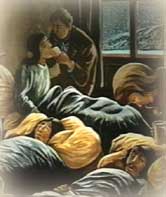 On the west coast of Greenland, in the tundra zone about one hundred
and fifty miles south of the arctic circle, a new colony was being
built. Europeans had established a presence in Greenland as early as 980
under Eric the Red. Severe winters and the problems of maintaining trade
caused the colony to perish 400 years later. Now, in 1722, the Danes
were reestablishing their presence. The leader of the expedition was not
a Dane, however. He was a tough-skinned Norwegian. More to the point, he
was a Christian missionary.
On the west coast of Greenland, in the tundra zone about one hundred
and fifty miles south of the arctic circle, a new colony was being
built. Europeans had established a presence in Greenland as early as 980
under Eric the Red. Severe winters and the problems of maintaining trade
caused the colony to perish 400 years later. Now, in 1722, the Danes
were reestablishing their presence. The leader of the expedition was not
a Dane, however. He was a tough-skinned Norwegian. More to the point, he
was a Christian missionary.Protestantism was slow to develop a missionary consciousness and commitment. The little nation of Denmark was among the first Protestant countries which recognized the urgency of spreading the gospel. It's leaders founded a mission school in 1714. Among the missions-minded was their ruler, the good king Frederick IV. Having come under the influence of Pietism, he strongly supported Danish missions, including the Greenland project. On this day, May 3, 1721, Hans Egede sailed with his wife Gertrude for the inhospitable regions of the world's largest island.
Greenland is a harsh land. No settlement is possible except along the coasts, for the interior of the world's largest island is ice-covered year round. In spite of all its ice, Greenland's northern regions are more arid than the driest Sahara, receiving less than five inches of rain a year. The southern coasts receive 30 inches a year. There grasses grow and some trees: alder, birch and willow. Hans Egede found both winter and summer beautiful despite the low average temperatures and pale sun that never rises high in the sky.
In 1722 he founded a colony and named it Godthåb. Known as Nuuk today, it is capital of the nation. From this base he preached to the Eskimos, but saw few indications of success. Superstition ran deep in these hardy Indians and they could not be weaned from the words of their angakut (soothsayers). The problems of teaching Christianity were compounded by Egede's difficulties mastering the Eskimo language. It seemed to have few words with which to express Christian concepts. Despite this, he attempted to produce a translation of the New Testament. Adding to all these barriers was his own temperament, which tended to be harsh and overbearing. He dearly loved the people, but like many Christians, did not know how to express this in human terms.
That changed in 1733 when a smallpox epidemic swept the island. Hans and his wife poured themselves heart and soul into caring for dying Greenlanders. "You have been kinder to us than we have been to one another," exclaimed one. Gertrude so exhausted herself in the effort that she died a short time later. Hans returned to Denmark in 1736.
His son Paul, raised among the Eskimos, took over the work, mastered the language, completed the translation, and witnessed revival. His father rejoiced to see him reap where he had sown.
Bibliography:
- "Egede, Hans." The Oxford Dictionary of the Christian Church. Edited by F. L. Cross and E. A. Livingstone. Oxford, 1997.
- Lives of missionaries, Greenland: Hans Egede; Matthew Stach and his associates. London, Society for Promoting Christian Knowledge, 186 -.
- Neill, Stephen. A History of Christian Missions. The Pelican History of the Church #6. Hammondsworth, Middlesex, England: Pelican Books, 1964.
- Fleisher, Eric W. & Jürgen Weibull. Viking Times to Modern; the story of Swedish exploring & settlement in America, and the development of trade & shipping from the Vikings to our time. Minneapolis, University of Minnesota Press, 1954; p. 143.